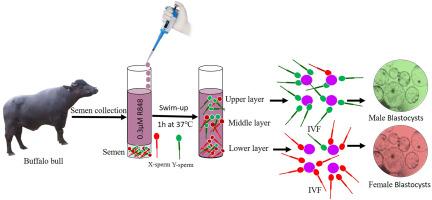使用TLR 7/8激动剂R848分离水牛X和Y精子:对卵裂率、囊胚产生和雌雄胚胎比例的影响
IF 2.5
2区 农林科学
Q3 REPRODUCTIVE BIOLOGY
引用次数: 0
摘要
该研究旨在使用TLR7/8激动剂R848分离X和Y水牛精子。收集3头Murrah水牛的精液,将其分成等份,在不同浓度R848(0、0.03、0.3和3 μM)的改良人输卵管液(mHTF)培养基中游泳。在处理和游泳后,使用计算机辅助精子分析仪(CASA)和流式细胞术评估最上层和最下层精液。免疫荧光法检测发现,约50%的精子中存在TLR7/8受体。精子速度(VCL、VAP、VSL)随着R848浓度的增加而降低,而线粒体健康(线粒体膜电位和超氧化物产生)不受影响。根据精子速度,选择0.3 μM R848处理后的精子进行体外受精。各组的卵裂率和囊胚率正常,分别在69% - 76%和21% - 26%之间,表明处理不影响卵裂率和囊胚率。在本研究中,利用胚胎性别测定来确定X和Y精子的分离效率。通过体外受精从最上层和最下层的精液中产生的囊胚分别产生75%的男性和75%的女性。因此,该研究开发了一种简单的新方法,可以有效地分离水牛的X和Y精子,从而实现雄性或雌性后代的选择性生产。本文章由计算机程序翻译,如有差异,请以英文原文为准。

Use of R848, a TLR 7/8 agonist to separate X and Y spermatozoa in buffalo: effects on cleavage rates, blastocyst production, and the ratio of male to female embryos
The study aimed to separate X and Y buffalo sperm using R848, a TLR7/8 agonist. Semen from three Murrah buffalo bulls were collected and divided into aliquots for swim-up in modified human tubal fluid (mHTF) medium with varying concentrations of R848 (0, 0.03, 0.3, and 3 μM). After the treatments and swim-up, the uppermost and lowermost layers of semen were assessed using computer-assisted sperm analyser (CASA) and flow cytometry. TLR7/8 receptors were found present in approximately 50 % of sperm as determined by immunofluorescence assay. Sperm velocities (VCL, VAP, VSL) decreased with increasing R848 concentrations, whereas mitochondrial health (mitochondrial membrane potential and superoxide production) remained unaffected. Based on sperm velocity, sperm treated with 0.3 μM R848 was selected for in vitro fertilization. The cleavage and blastocyst production rates were normal across the groups, ranging from 69 % to 76 % and 21 %–26 %, respectively, indicating the treatment does not affect cleavage and blastocyst production rates. In this study, the efficiency of separating X and Y sperm was determined using embryo sexing. The blastocysts produced from the uppermost and lowermost layers of semen through IVF resulted in 75 % male and 75 % female, respectively. Thus, the study develops a simple new method for efficiently separating X and Y sperm in buffalo, enabling the selective production of male or female progeny.
求助全文
通过发布文献求助,成功后即可免费获取论文全文。
去求助
来源期刊

Theriogenology
农林科学-生殖生物学
CiteScore
5.50
自引率
14.30%
发文量
387
审稿时长
72 days
期刊介绍:
Theriogenology provides an international forum for researchers, clinicians, and industry professionals in animal reproductive biology. This acclaimed journal publishes articles on a wide range of topics in reproductive and developmental biology, of domestic mammal, avian, and aquatic species as well as wild species which are the object of veterinary care in research or conservation programs.
 求助内容:
求助内容: 应助结果提醒方式:
应助结果提醒方式:


